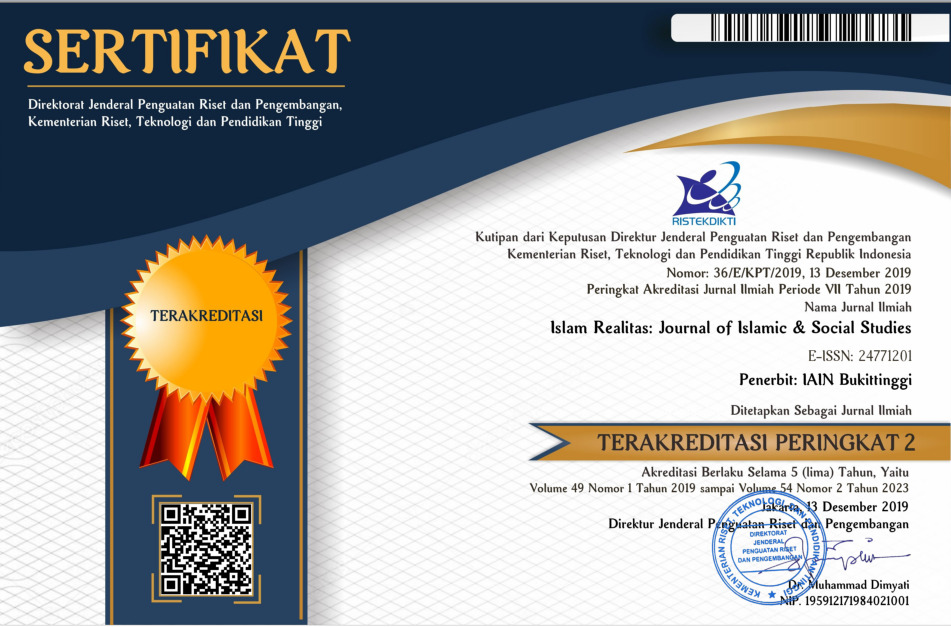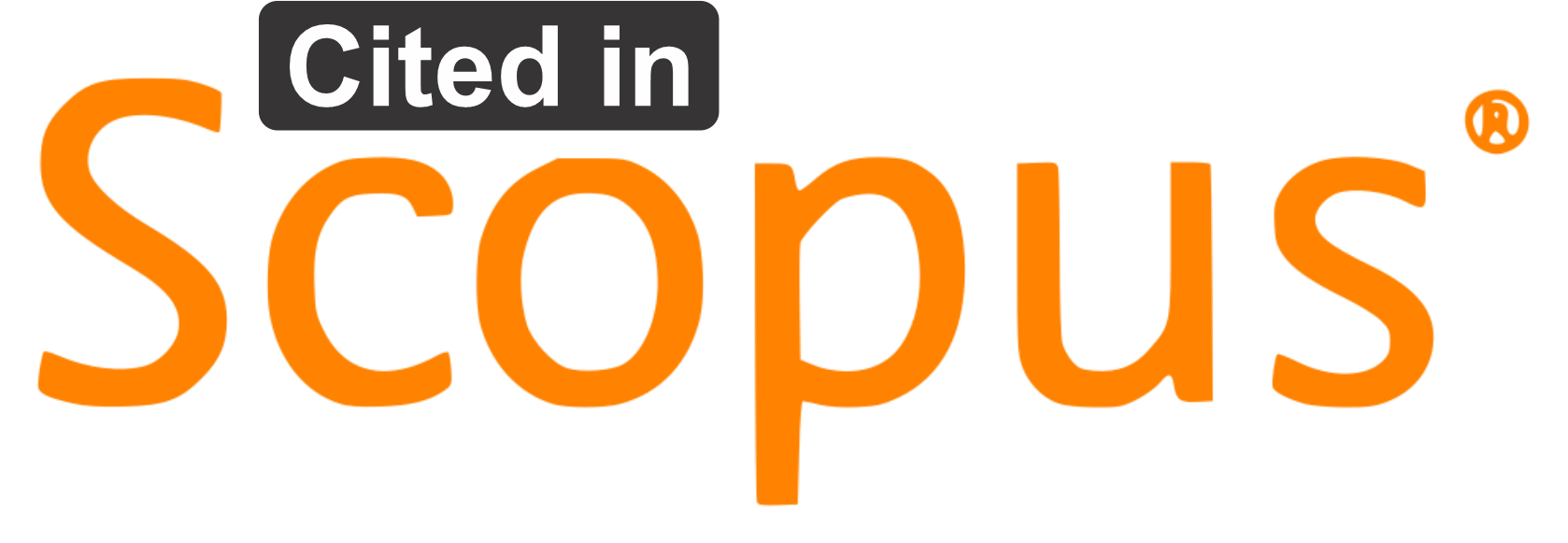Transforming the Religious Enthusiasm of Urban Muslims in the Choosing of Elementary-Level Education in Purwokerto, Indonesia
Downloads
This paper aims to analyze religious enthusiasm that does not continue after the primary school period is over and instead shows contrasting situations. Urban Muslims in Purwokerto, Indonesia, show high religious enthusiasm when choosing primary schools for their children. The number of public elementary school students has declined in the last five years, while Madrasah Ibtida'iyyah has increased dramatically. This research is field-type with data sources from urban Muslims who choose Madrasah Ibtida'iyyah as a primary school choice for their children. The data were analyzed qualitatively using a sociological approach. The study found that the religious enthusiasm of urban Muslims is pragmatic. Their pragmatic nature is shown by the resistance of different social groups that give rise to covert conflicts. In addition, they form new communities that actively represent them in public spaces. This finding has implications for a change in the perspective of the phenomenon of religious enthusiasm from theological awareness to a new trend of community-based urban Muslim pragmatism. Further research recommended the representation of the new identity of Muslim communities in virtual public spaces.
Tulisan ini bertujuan menganalisis antusiasme keagamaan orang tua yang tidak berlanjut pada jenjang pendidikan setelah Sekolah Dasar dan justru menunjukkan situasi yang kontras. Muslim perkotaan di Purwokerto, Indonesia, menunjukkan antusiasme agama yang tinggi dalam memilih Sekolah Dasar untuk anak-anak mereka. Jumlah siswa Sekolah Dasar Negeri mengalami penurunan dalam lima tahun terakhir, sebaliknya Madrasah Ibtida'iyyah meningkat secara drastis.. Penelitian ini berjenis lapangan dengan sumber data dari kelompok muslim perkotaan yang memilih Madrasah Ibtida'iyyah sebagai pilihan sekolah dasar untuk anak-anak mereka. Data dianalisis secara kualitatif dengan menggunakan pendekatan sosiologis. Studi ini menemukan bahwa antusiasme keagamaan muslim perkotaan bersifat pragmatis. Sifat pragmatis mereka ditunjukkan melalui perlawanan dan menimbulkan konflik terselubung. Selain itu, mereka membentuk komunitas baru yang secara aktif merepresentasikannya di ruang publik. Temuan ini berimplikasi pada perubahan perspektif fenomena antusiasme keagamaan dari kesadaran teologis ke kecenderungan baru pragmatisme. Penelitian lebih lanjut merekomendasikan representasi identitas baru komunitas muslim di ruang publik virtual.
Books
Abu-Rabi, Ibrahim M. “A Post September 11 Critical Assessment of Modern Islamic History.” In 11 September Religious Perspective on the Causes and Consequences, edited by Ian Markham and Ibrahim M.Abu Rabi. Oxford: One World, 2002.
Amonoo, James. “Factors Influencing Parents’ Choice of a Senior High School for Their Children’,” 2014.
Durkheim, Emile. The Elementary Forms of Religious. New York: Life-Free Press, 1995.
Geertz, Clifford. “Religion as a Cultural System’.” In Anthropological Approaches to the Study of Religion (Routledge, 1–46, 2013.
Jacobson, Jessica. “Islam in Transition: Religion and Identity among British Pakistani Youth’,” 2015.
Jensen, Jeppe Sinding. What Is Religion? Routledge, 2019.
Lapsley, Daniel K, and Darcia Narvaez. “Character Education’.” In Handbook of Child Psychology, 4. 2:248–96, 2006.
Schulz, Dorothea E. “Remaking Society from within Extraversion and the Social Forms of Female Muslim Activism in Urban Mali’.” In Development and Politics from Below: Exploring Religious Spaces in the African State, 74–96. London: Palgrave Macmillan UK, 2010.
Journals
Abwi, Zulfa Ridhani, Saiful Amien, and Muhammad Yusuf. “Improving Students’ Learning Enthusiasm for the Islamic Education Subject Using Wordwall.” Edunesia: Jurnal Ilmiah Pendidikan 4, no. 2 (April 7, 2023): 671–81. https://doi.org/10.51276/edu.v4i2.439.
Ahmad, Iftikhar, and Michelle Y Szpara. “Muslim children in urban America: The New York city schools experience.” Journal of Muslim Minority Affairs 23, no. 2 (October 2003): 295–301. https://doi.org/10.1080/1360200032000139938.
Ali, Syed. “Collective and Elective Ethnicity: Caste among Urban Muslims in India’.” In Sociological Forum, 593–620, 2002.
Andrienko, Natalia, Gennady Andrienko, Louise Barrett, Marcus Dostie, and Peter Henzi. “Space Transformation for Understanding Group Movement’.” IEEE Transactions on Visualization and Computer Graphics 19. 12 (2013): 2169–78.
Ardianto, Puthut, and Muhamat Ridho Yuliyanto. “‘I Am Enthusiastic!’: Exploring Students’ Responses on the Roleplay Assignment.” Academic Journal Perspective : Education, Language, and Literature 8, no. 2 (November 30, 2020): 135–46. https://doi.org/10.33603/perspective.v8i2.3974.
Arena, Michael J, and Mary Uhl-Bien. “Complexity Leadership Theory: Shifting from Human Capital to Social Capital’.” People and Strategy 39. 2 (2016): 22.
Ashforth, Adam. “AIDS, Religious Enthusiasm and Spiritual Insecurity in Africa’.” In Religious Responses to HIV and AIDS, 6–21. Routledge, 2016.
Auh, Seongyeon, and Christine C Cook. “Quality of Community Life among Rural Residents: An Integrated Model’.” Social Indicators Research 94 (2009): 377–89.
Batty, Michael, J. Michael Collins, and Elizabeth Odders‐White. “Experimental Evidence on the Effects of Financial Education on Elementary School Students’ Knowledge, Behavior, and Attitudes.” Journal of Consumer Affairs 49, no. 1 (March 29, 2015): 69–96. https://doi.org/10.1111/joca.12058.
Berdahl, Jennifer L, and Paul Martorana. “Effects of Power on Emotion and Expression during a Controversial Group Discussion.” European Journal of Social Psychology 36, no. 4 (July 17, 2006): 497–509. https://doi.org/10.1002/ejsp.354.
Beta, Annisa R. “Hijabers: How Young Urban Muslim Women Redefine Themselves in Indonesia.” International Communication Gazette 76, no. 4–5 (June 7, 2014): 377–89. https://doi.org/10.1177/1748048514524103.
Biesta, Gert. “Becoming Public: Public Pedagogy, Citizenship and the Public Sphere.” Social & Cultural Geography 13, no. 7 (November 2012): 683–97. https://doi.org/10.1080/14649365.2012.723736.
Bloch, Maurice. “Why Religion Is Nothing Special but Is Central.” Edited by Colin Renfrew, Chris Frith, and Lambros Malafouris. Philosophical Transactions of the Royal Society B: Biological Sciences 363, no. 1499 (June 12, 2008): 2055–61. https://doi.org/10.1098/rstb.2008.0007.
Bosker, Maarten, Eltjo Buringh, and Jan Luiten van Zanden. “From Baghdad to London: Unraveling Urban Development in Europe, the Middle East, and North Africa, 800–1800.” The Review of Economics and Statistics 95, no. 4 (October 1, 2013): 1418–37. https://doi.org/10.1162/REST_a_00284.
Cesur, Resul, and Naci Mocan. “Education, Religion, and Voter Preference in a Muslim Country’.” Journal of Population Economics 31 (2018): 1–44.
Cleary, Anne, and Teresa Brannick. “Suicide and Changing Values and Beliefs in Ireland.” Crisis 28, no. 2 (March 2007): 82–88. https://doi.org/10.1027/0227-5910.28.2.82.
Denning, Stephanie. “Religious Faith, Effort and Enthusiasm: Motivations to Volunteer in Response to Holiday Hunger.” Cultural Geographies 28, no. 1 (January 24, 2021): 57–71. https://doi.org/10.1177/1474474020933894.
Deri Wanto, Jalwis, Ahmad Jamin, and Ramsah Ali. “Asserting Religiosity in Indonesian Muslim Urban Communities through Islamic Education: An Experience of Indonesia.” Journal of Islamic Thought and Civilization 12, no. 2 (October 11, 2022): 116–35. https://doi.org/10.32350/jitc.122.09.
Duxbury, Nancy, and Heather Campbell. “Developing and Revitalizing Rural Communities through Arts and Culture’.” Small Cities Imprint 3. 1 (2011): 16–32.
Echevarría Arsuaga, Ana. “Urban Development and Muslim Minorities in the Middle Ages: The Path to Invisibility.” Hamsa 7, no. 7 (June 22, 2021). https://doi.org/10.4000/hamsa.1103.
Ellis, Anthony. “What Is Special about Religion?’.” Law and Philosophy 25. 2 (2006): 219–41. https://doi.org/https://www.jstor.org/stable/27639429.
Filho, Walter Leal et all. “International Trends on Transformative Learning for Urban Sustainability’.” Discover Sustainability 4. 31 (2023): 1–20.
Gladney, Dru. “Making Muslims in China: Education, Islamicization and Representation’.” In China’s National Minority Education (Routledge, 55–94, 2013.
Habermas, Jürgen. “Religion in the Public Sphere.” Edited by Kibujjo M. Kalumba. Philosophia Africana 8, no. 2 (2005): 99–109. https://doi.org/10.5840/philafricana2005823.
Hidayati, Dian, and Andi Arif Rifa’i. “Factors Influencing Parents’ Decisions on Choosing an Islamic Primary School in Bandung Indonesia.” Randwick International of Social Science Journal 1, no. 1 (April 25, 2020): 121–26. https://doi.org/10.47175/rissj.v1i1.15.
Hilmy, Masdar. “Towards a Religiousy Hybrid Identitu? The Changing Face of Javanese Islam.” Journal of Indonesian Islam 12, no. 1 (June 1, 2018): 45. https://doi.org/10.15642/JIIS.2018.12.1.45-68.
Hofferth, Sandra L, and John Iceland. “Social Capital in Rural and Urban Communities 1.” Rural Sociology 63, no. 4 (December 17, 1998): 574–98. https://doi.org/10.1111/j.1549-0831.1998.tb00693.x.
Iner, Derya. “Faith-Inspired Muslim Parents’ School Choices and Attitudes in the Cultural West and Australia.” Religions 12, no. 9 (September 10, 2021): 746. https://doi.org/10.3390/rel12090746.
Jakimow, Tanya. “A Moral Atmosphere of Development as a Share: Consequences for Urban Development in Indonesia’.” World Development 108 (2018): 47–56.
Kaczmarek, Lukasz D, Todd B Kashdan, Maciej Behnke, Martyna Dziekan, Ewelina Matuła, Michał Kosakowski, Jolanta Enko, and Przemysław Guzik. “Positive Emotions Boost Enthusiastic Responsiveness to Capitalization Attempts. Dissecting Self-Report, Physiology, and Behavior’.” Journal of Happiness Studies 7. 2 (2021): 1–19.
Kirmani, Nida. “The Role of Religious Values and Beliefs in Charitable and Development Organizations in Karachi and Sindh, Pakistan’.” Development in Practice 22 (2012): 5–6.
Kohout-Diaz, Magdalena. “School Marketing and Segmentation: A Comparative Study in Bulgaria and the Czech Republic’.” International Journal of Educational Research 90. 2 (2018): 87–94.
Larson, Scott. “Histrionics of the Pulpit: Trans Tonalities of Religious Enthusiasm’.” Transgender Studies Quarterly 6. 3 (2019): 315–37.
Lord, Ceren. “Between Islam and the Nation; Nation‐building, the Ulama and Alevi Identity in Turkey’.” Nations and Nationalism 23. 2 (2017): 48–67.
Moghadasi, Javad, and Leila Keikavoosi-Arani. “Investigating the Factors Influencing Students’ Academic Enthusiasm for a Shift of Paradigm among Education Managers Shaping Academic Pedagogy’.” BMC Medical Education, 2023, 1–13.
Peters, Karin, Birgit Elands, and Arjen Buijs. “Social Interactions in Urban Parks: Stimulating Social Cohesion?’.” Urban Forestry & Urban Greening 9. 2 (2010): 93–100.
Risha, Dr Sarah. “Islam as Identity: Religious Awareness’.” Addaiyan Journal of Arts, Humanities and Social Sciences, 2021, 79–97.
Roberts, Elisabeth, David Beel, Lorna Philip, and Leanne Townsend. “Rural resilience in a digital society: Editorial.” Journal of Rural Studies 54 (August 2017): 355–59. https://doi.org/10.1016/j.jrurstud.2017.06.010.
Royani, Ahmad, and Hepni. “The Survival and Continuity of Islamic Boarding School in the Era of Changes’.” Jurnal Penelitian 19. 2 (2022): 129–38. https://doi.org/10.28918/jupe.v19i2.1073.
Royanulloh, Royanulloh, Thiyas Tono Taufiq, and Komari. “Representation of the Meaning of the Expression of Hijrah for Urban Muslim Community through Instagram: A Virtual Ethnographic Study.” Journal of Islamic Civilization 4, no. 1 (September 30, 2022): 68–80. https://doi.org/10.33086/jic.v4i1.2804.
Sender, John. “Women’s Struggle to Escape Rural Poverty in South Africa.” Journal of Agrarian Change 2, no. 1 (January 16, 2002): 1–49. https://doi.org/10.1111/1471-0366.00023.
Shalihin, N, and M U Amri. “An Evaluation of Women and the Ideological Interest of the Integrated Islamic School’.” Jurnal Penelitian 19. 2 (2022): 167–78. https://doi.org/10.28918/jupe.v19i2.1076.
Sherraden, Margaret Sherrard, Lissa Johnson, Baorong Guo, and William Elliott. “Financial Capability in Children: Effects of Participation in a School-Based Financial Education and Savings Program’.” Journal of Family and Economic Issues 32 (2011): 385–99.
Singh, Balraj. “Character Education in the 21st Century.” Journal of Social Studies (JSS) 15, no. 1 (May 29, 2019): 1–12. https://doi.org/10.21831/jss.v15i1.25226
Sukmayadi, Vidi. “Indonesian Education Landscape and the 21st Century Challenges’.” Journal of Social Studies Education Research 11. 4 (2020): 219–34. https://doi.org/https://www.learntechlib.org/p/218538/.
Williams, Nathalie E., Arland Thornton, and Linda C. Young-DeMarco. “Migrant Values and Beliefs: How Are They Different and How Do They Change?” Journal of Ethnic and Migration Studies 40, no. 5 (May 4, 2014): 796–813. https://doi.org/10.1080/1369183X.2013.830501.
Zaenuddin, Dundin. “Religion and Social Capital of Citizenship: Bogor Islamic Community in a Globalizing World Development.” International Journal of Interreligious and Intercultural Studies 3, no. 2 (December 3, 2020): 86–100. https://doi.org/10.32795/ijiis.vol3.iss2.2020.1093.
Zhang, Wei, and Gillian Lawson. “Meeting and Greeting: Activities in Public Outdoor Spaces Outside High-Density Urban Residential Communities’.” Urban Design International 14, no. 1 (2009): 207–14.
Interview
Yusuf (Employee of State-Owned Enterprises) Interview (March 10, 2024).
Yusuf (Employee of State-Owned Enterprise) Interview (December 5, 2023).
Supracoyo (Private Employee) Interview (November 11, 2023).
Aini (Entrepreneur) Interview (March 21, 2024).
Istiqamah (Entrepreneur) Interview (November 10, 2024).
Herta Halim (Civil Servant) Interview (March 14, 2024).
Amin Karuniawan (Employee of State-Owned Enterprises) Interview (November 12, 2023).
Copyright (c) 2024 Ahmad Muttaqin, Ifada Novikasari

This work is licensed under a Creative Commons Attribution-ShareAlike 4.0 International License.
Authors who publish with this journal agree to the following terms:
- Authors retain copyright and grant the journal right of first publication with the work simultaneously licensed under a Creative Commons Attribution License that allows others to share the work with an acknowledgment of the work's authorship and initial publication in this journal.
- Authors are able to enter into separate, additional contractual arrangements for the non-exclusive distribution of the journal's published version of the work (e.g., post it to an institutional repository or publish it in a book), with an acknowledgment of its initial publication in this journal.
- Authors are permitted and encouraged to post their work online (e.g., in institutional repositories or on their website) prior to and during the submission process, as it can lead to productive exchanges, as well as earlier and greater citation of published work (See The Effect of Open Access).









